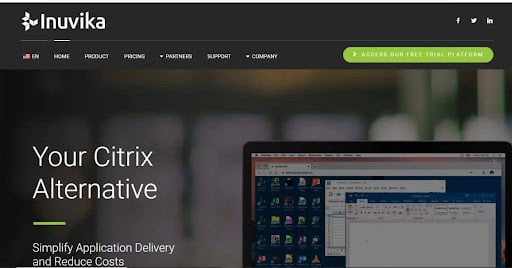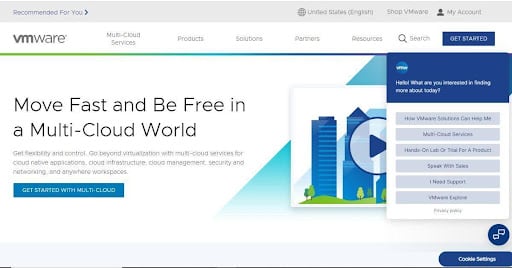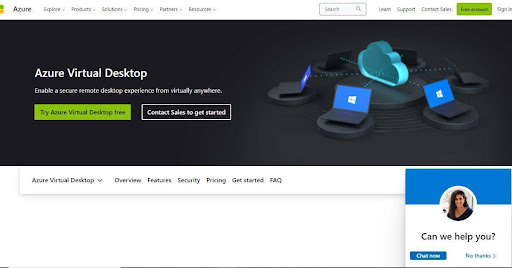L'installation d'un bureau peut s'accompagner de coûts technologiques élevés.
Cela s'explique en grande partie par les coûts matériels élevés liés à l'achat et à la maintenance de machines physiques telles que des ordinateurs de bureau et des serveurs pour chacun de vos employés.
Dans l'ensemble, L'installation d'un bureau de manière traditionnelle, l'achat d'ordinateurs portables coûteux pour chaque employé afin de gérer le nouvel environnement de travail hybride et l'absence de logiciel de bureau virtuel peuvent entraîner une baisse considérable de vos résultats.
En fait, selon une enquête de l'ESG, 42% des organisations ont cité la réduction des coûts informatiques comme leur principale priorité. Cela prouve que de nombreuses entreprises dépensent plus qu'elles ne le souhaitent pour leur infrastructure informatique.
Pour garantir la rentabilité, vous devez utiliser un logiciel de bureau virtuel.
En vous permettant de mettre en œuvre un modèle "Apportez votre propre appareil au travail" ou de fournir à vos employés des clients légers peu coûteux, les logiciels de bureau virtuel compensent vos coûts de matériel.
Ils vous permettent également d'économiser de l'argent en réduisant vos frais d'entretien.
Dans cet article, je vais vous guider à travers les meilleurs logiciels de bureau virtuel pour les petites entreprises et les entreprises en 2024 qui rendront votre flux de travail très rentable et productif.
Commençons.
3 conseils pour choisir un logiciel de bureau virtuel
a) Penser à l'évolutivité
Au fil du temps, vos besoins en logiciels de bureau virtuel peuvent évoluer.
Vous devez donc opter pour un logiciel de bureau virtuel capable de s'adapter facilement à ce changement. Vous devez donc choisir des outils dotés d'options de licence flexibles. Vous gagnerez ainsi du temps et de l'argent en évitant de devoir changer de solution en cours de route.
b) Prendre en compte le coût total de possession
Au-delà des seuls frais d'abonnement, il est également prudent de tenir compte des coûts de mise en œuvre et de maintenance.
En ce qui concerne les facteurs de choisir son logiciel de bureau virtuelLe coût total de possession est essentiel car il permet de déterminer la durabilité de la solution.
c) Priorité aux fonctions d'intégration
Pour la plupart des petites entreprises, une infrastructure informatique est déjà en place.
Le meilleur logiciel de bureau virtuel est donc celui qui possède des fonctions d'intégration et de compatibilité avec vos solutions de stockage de données, vos appareils et vos applications actuels. Cela vous évitera d'avoir à procéder à des révisions coûteuses.
d) Choisir entre la virtualisation des postes de travail et la virtualisation des applications
La plupart des fournisseurs offrent le choix entre un poste de travail entièrement virtualisé, appelé infrastructure de bureau virtuel ou VDI, et des applications virtualisées. Il y a très peu de cas où les applications doivent être exécutées sur VDI, de sorte que dans la plupart des cas, la virtualisation d'applications, moins coûteuse, serait le choix des petites entreprises.
e) Utilisateurs simultanés et utilisateurs nommés
Certains fournisseurs facturent en fonction du nombre d'utilisateurs individuels accédant au bureau, tandis que d'autres facturent en fonction du nombre d'utilisateurs simultanés. Si vous avez plusieurs équipes de travail ou de nombreux travailleurs à temps partiel, vous économiserez probablement de l'argent en choisissant un modèle d'utilisateurs simultanés.
1. Inuvika

Inuvika offre l'une des courbes d'apprentissage les plus faciles en matière d'outils de bureau virtuel.
Avec une seule console d'administration simple, par rapport à la plupart des autres solutions qui en ont plusieurs, il est plus facile à administrer. Cette centralisation des contrôles facilite également la gestion de vos employés pour une meilleure productivité.
En outre, il peut fournir des applications Windows, mais il est construit sur Linux, de sorte qu'il supprime la plupart des licences Microsoft et offre un coût total de possession inférieur de 50% à la moyenne des prix du marché.
Cela en fait donc une application virtuelle ou un logiciel de bureau virtuel très rentable si vous disposez d'un budget très serré.
Dans l'ensemble, je pense qu'Inuvika convient le mieux aux PME et aux entreprises de 2024 qui souhaitent simplifier la fourniture d'applications avec un logiciel de bureau virtuel dont les besoins d'intégration sont minimes afin de garantir un déploiement plus rapide et des temps d'arrêt réduits au minimum.
Meilleures caractéristiques :
- Prise en charge native de Zoom et de Microsoft Teams, ce qui vous permet d'intégrer facilement vos outils sous-jacents pour une mise en œuvre plus rapide.
- Une conception sans confiance qui fonctionne avec l'authentification multifactorielle d'Inuvika et un accès utilisateur contrôlé pour sécuriser votre flux de travail et prévenir les violations de données.
- La virtualisation d'applications sous Linux qui réduit les besoins en licences et les coûts qui en découlent afin d'assurer une meilleure rentabilité de votre flux de travail.
Prix :
- Le prix commence à $11.20/utilisateur simultané par mois.
2. Citrix

Si vous travaillez dans un secteur où les normes de conformité sont strictes, Citrix est une excellente option.
Cela est dû à la capacité de Citrix à fournir une infrastructure de bureau virtuel hautement gérée, avec des contrôles de sécurité adaptatifs, qui vous aide à sécuriser les données sensibles et à respecter la ligne de conduite des régulateurs.
Par le biais de la fonction "desktop as a service" (bureau en tant que service), Citirix vous permet également de créer un espace de travail numérique de haute performance qui peut évoluer de façon astronomique.
Cela est possible grâce à la technologie hybride multi-cloud du logiciel.
Par conséquent, pour les petites entreprises et les entreprises qui souhaitent maximiser les partenariats, que ce soit avec Google Cloud Platform ou Microsoft Azure, il s'agit du meilleur logiciel de bureau virtuel pour vous aider à évoluer.
Cela dit, Citrix est surtout idéal pour les petites entreprises et les entreprises qui travaillent avec des données particulièrement sensibles et qui doivent donc sécuriser leurs flux de travail hybrides pour éviter les brèches et les menaces internes.
Meilleures caractéristiques :
- Des applications 3D et des outils de communication unifiée qui offrent un espace de travail cohérent et de haute qualité, même lorsque la bande passante est faible.
- L'analyse du comportement des utilisateurs vous permet d'automatiser les contrôles afin de rationaliser les opérations de sécurité et d'améliorer la détection et la réponse aux incidents.
- Un environnement de gestion des utilisateurs léger qui vous permet d'améliorer l'évolutivité du serveur afin de garantir de meilleures performances et une meilleure disponibilité.
Prix :
- Le prix commence à $14/utilisateur par mois.
3. VMware

S'appuyant sur la technologie multi-cloud, VMware améliore l'agilité des PME et des entreprises.
Pour ce faire, il unifie toutes vos architectures en nuage, brisant ainsi les silos qui existent traditionnellement entre elles afin de favoriser la croissance.
Cela est possible grâce à une pile opérationnelle et administrative centralisée, qui rend également plus efficace et plus facile la gestion et la sécurisation de vos différents environnements en nuage.
En outre, Les services cross-cloud de VMware libèrent votre flux de travail des contraintes géographiques pour améliorer l'expérience et la productivité de vos employés..
En particulier, ces services inter-cloud offrent une normalisation pour l'accès, la construction et l'exploitation des applications.
Cela permet d'éliminer la confusion et d'améliorer la qualité du service et la productivité.
Si l'on tient compte de tous ces éléments, je pense que VMware est le meilleur logiciel de bureau virtuel pour les PME et les entreprises de 2024 qui souhaitent gérer de manière plus efficace et plus rentable une main-d'œuvre distribuée, composée d'employés à distance, hybrides et au bureau.
Meilleures caractéristiques :
- La gestion unifiée des terminaux offre une solution unique pour gérer les applications et les employés afin de stimuler votre productivité.
- Des outils numériques d'expérience des employés qui vous aident à assurer le bien-être du personnel afin d'augmenter les taux de rétention et, par conséquent, les coûts d'embauche.
- L'analyse avancée de l'espace de travail vous donne des informations exploitables pour améliorer les processus de l'espace de travail et rendre votre flux de travail plus rentable.
Prix :
- Contactez VMware pour connaître les tarifs.
4. Les parallèles

Parallels offre un déploiement multi-locataires pour améliorer vos efforts d'optimisation des ressources.
Plus précisément, différents utilisateurs peuvent accéder à une instance d'une application, ce qui est possible grâce à l'équilibrage de la charge à haute disponibilité qui permet de réduire les temps d'arrêt.
Une console d'administration unique facilite la gestion de tous les utilisateurs tout en simplifiant le déploiement et la gestion.
Avec un licensing simple et une formation technique gratuite, Parallels est également très apprécié pour sa capacité à réduire votre coût total de possession.
Ce rapport coût-efficacité s'explique aussi en grande partie par le fait que l'entreprise est multilocataire.
Une autre caractéristique clé de Parallels est la possibilité de mélanger vos charges de travail, permettant une gestion du workflow qui favorise l'efficacité et la rentabilité.
A la lumière de cela, je trouve que Parallels est le meilleur logiciel de bureau virtuel pour les PME et les entreprises qui veulent faciliter le partage des données et améliorer la collaboration pour garantir une plus grande réussite dans la résolution des problèmes.
Meilleures caractéristiques :
- Une architecture multi-locataires qui vous permet d'améliorer l'efficacité des ressources et donc de réduire les coûts afin de garantir des marges de revenus plus élevées.
- Des mesures intégrées de conformité et de sécurité de bout en bout qui vous aident à sécuriser votre flux de travail contre les menaces avancées, augmentant ainsi votre temps de fonctionnement.
- Une console d'administration unifiée qui vous permet de gérer efficacement différents espaces de travail afin d'obtenir une meilleure coordination et une productivité accrue.
Prix :
- Le prix commence à $120/utilisateur actuel par an.
5. Bureau virtuel Azure

Si vous utilisez déjà diverses applications Windows, cette plateforme peut vous aider à les déployer rapidement.
Doté d'un avantage multisession qui vous permet d'empiler plusieurs utilisateurs sur une seule machine, Azure Virtual Desktop vous intègre facilement dans l'environnement complet de Microsoft.
Azure Virtual Desktop offre également des contrôles automatisés de la mise à l'échelle et une tarification flexible, basée sur la consommation, afin que vous puissiez mieux gérer l'évolution des besoins de votre flux de travail.
C'est pourquoi ce logiciel est également idéal si vous avez des besoins d'utilisation imprévisibles. L'inconvénient est que ce produit n'est disponible que si votre entreprise est sur le nuage Azure. Il n'est donc pas disponible pour une installation sur site. De plus, il est un peu cher.
En fin de compte, cependant, Azure est le meilleur logiciel de bureau virtuel pour les petites entreprises et les entreprises qui veulent être entièrement dans l'environnement Microsoft.
Meilleures caractéristiques :
- Solution entièrement optimisée pour Windows 10 et 11, qui vous permet de déployer et de mettre à l'échelle en quelques minutes seulement. Cela accélère l'intégration des logiciels pour stimuler la productivité.
- Des fonctions d'intégration pour les logiciels de bureau virtuel Citrix et VMware, afin de minimiser les temps d'arrêt et de maximiser le retour sur investissement.
- La diffusion d'applications à distance réduit la latence des applications, ce qui permet à vos employés d'améliorer leurs performances et leur chiffre d'affaires.
Prix :
- Utilisez cet outil pour calculer le prix pour Azure
Conclusion
Si vous renoncez à un logiciel de bureau virtuel, vous désavantagez votre flux de travail par rapport à la concurrence.
Cela s'explique en grande partie par le fait que vous serez lent à réagir au changement en raison de la mobilité limitée de l'entreprise et des travailleurs. D'autre part, vos concurrents seront prompts à capitaliser avant vous.
En fin de compte, l'absence d'une application virtuelle ou d'un logiciel de bureau virtuel de qualité permet à vos concurrents de prendre l'avantage.
Avec un 50% taux d'adoption par les entreprises pour les logiciels de bureau virtuel rien qu'en Europe et en Amérique du Nord, selon un rapport de Spiceworks, ce qui prouve que nombre de vos concurrents utilisent peut-être déjà une stratégie informatique supérieure.
Par conséquent, vous devez tirer parti du meilleur logiciel de bureau virtuel pour les petites entreprises et les entreprises en 2024 pour garder votre entreprise plus agile, compétitive et rentable.
Si vous souhaitez un logiciel de bureau virtuel avec une courbe d'apprentissage douce, je vous recommande Inuvika. Il est particulièrement intéressant pour les petites entreprises qui recherchent une option économique pour un logiciel de bureau virtuel fiable.
Avec l'aimable autorisation de Market Business News - https://marketbusinessnews.com/5-best-virtual-desktop-software-for-small-businesses-enterprises-in-2024/359017/

